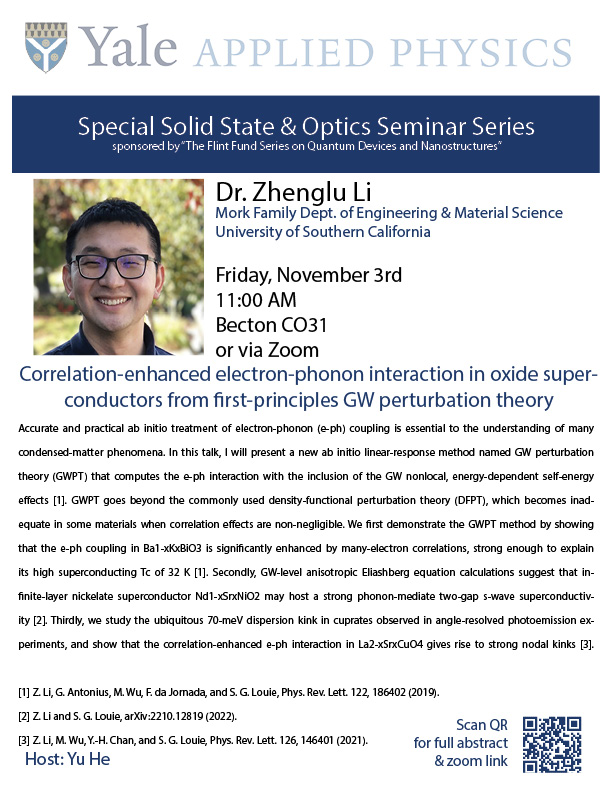Solid State & Optics Seminar
sponsored by “The Flint Fund Series on Quantum Devices and Nanostructures”
Zhenglu Li, USC
Date : Friday, 11/3/23
Time: 11:00 AM
Location: Becton CO31 or Zoom
Title/Abstract: Correlation-enhanced electron-phonon interaction in oxide superconductors from first-principles GW perturbation theory
Accurate and practical ab initio treatment of electron-phonon (e-ph) coupling is essential to the understanding of many condensed-matter phenomena. In this talk, I will present a new ab initio linear-response method named GW perturbation theory (GWPT) that computes the e-ph interaction with the inclusion of the GW nonlocal, energy-dependent self-energy effects [1]. GWPT goes beyond the commonly used density-functional perturbation theory (DFPT), which becomes inadequate in some materials when correlation effects are non-negligible. We first demonstrate the GWPT method by showing that the e-ph coupling in Ba1-xKxBiO3 is significantly enhanced by many-electron correlations, strong enough to explain its high superconducting Tc of 32 K [1]. Secondly, GW-level anisotropic Eliashberg equation calculations suggest that infinite-layer nickelate superconductor Nd1-xSrxNiO2 may host a strong phonon-mediate two-gap s-wave superconductivity [2]. Thirdly, we study the ubiquitous 70-meV dispersion kink in cuprates observed in angle-resolved photoemission experiments, and show that the correlation-enhanced e-ph interaction in La2-xSrxCuO4 gives rise to strong nodal kinks [3].
[1] Z. Li, G. Antonius, M. Wu, F. da Jornada, and S. G. Louie, Phys. Rev. Lett. 122, 186402 (2019).
[2] Z. Li and S. G. Louie, arXiv:2210.12819 (2022).
[3] Z. Li, M. Wu, Y.-H. Chan, and S. G. Louie, Phys. Rev. Lett. 126, 146401 (2021).
